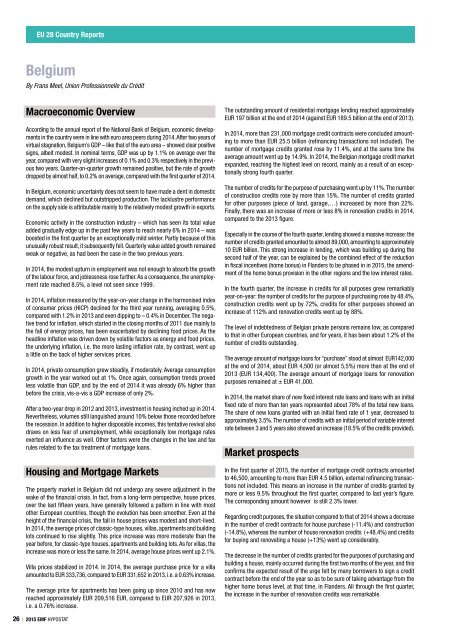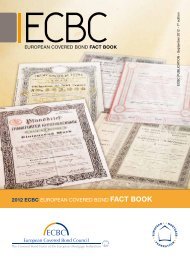Hypostat 2015
On 30 September 2015, the EMF-ECBC published Hypostat 2015 , which is its main statistical report, encompassing data on recent developments in housing and mortgage markets in the EU28 and beyond. Hypostat is the result of a collaborative effort by the European Mortgage Federation’s national delegations and external experts. The publication covers 33 countries – i.e. the EU28 plus Iceland, Norway, Russia, Turkey and the United States.
On 30 September 2015, the EMF-ECBC published Hypostat 2015 , which is its main statistical report, encompassing data on recent developments in housing and mortgage markets in the EU28 and beyond. Hypostat is the result of a collaborative effort by the European Mortgage Federation’s national delegations and external experts.
The publication covers 33 countries – i.e. the EU28 plus Iceland, Norway, Russia, Turkey and the United States.
Create successful ePaper yourself
Turn your PDF publications into a flip-book with our unique Google optimized e-Paper software.
EU 28 Country Reports<br />
Belgium<br />
By Frans Meel, Union Professionnelle du Crédit<br />
Macroeconomic Overview<br />
According to the annual report of the National Bank of Belgium, economic developments<br />
in the country were in line with euro area peers during 2014. After two years of<br />
virtual stagnation, Belgium’s GDP – like that of the euro area – showed clear positive<br />
signs, albeit modest. In nominal terms, GDP was up by 1.1% on average over the<br />
year, compared with very slight increases of 0.1% and 0.3% respectively in the previous<br />
two years. Quarter-on-quarter growth remained positive, but the rate of growth<br />
dropped by almost half, to 0.2% on average, compared with the first quarter of 2014.<br />
In Belgium, economic uncertainty does not seem to have made a dent in domestic<br />
demand, which declined but outstripped production. The lacklustre performance<br />
on the supply side is attributable mainly to the relatively modest growth in exports.<br />
Economic activity in the construction industry – which has seen its total value<br />
added gradually edge up in the past few years to reach nearly 6% in 2014 – was<br />
boosted in the first quarter by an exceptionally mild winter. Partly because of this<br />
unusually robust result, it subsequently fell. Quarterly value added growth remained<br />
weak or negative, as had been the case in the two previous years.<br />
In 2014, the modest upturn in employment was not enough to absorb the growth<br />
of the labour force, and joblessness rose further. As a consequence, the unemployment<br />
rate reached 8.5%, a level not seen since 1999.<br />
In 2014, inflation measured by the year-on-year change in the harmonised index<br />
of consumer prices (HICP) declined for the third year running, averaging 0.5%,<br />
compared with 1.2% in 2013 and even dipping to – 0.4% in December. The negative<br />
trend for inflation, which started in the closing months of 2011 due mainly to<br />
the fall of energy prices, has been exacerbated by declining food prices. As the<br />
headline inflation was driven down by volatile factors as energy and food prices,<br />
the underlying inflation, i.e. the more lasting inflation rate, by contrast, went up<br />
a little on the back of higher services prices.<br />
In 2014, private consumption grew steadily, if moderately. Average consumption<br />
growth in the year worked out at 1%. Once again, consumption trends proved<br />
less volatile than GDP, and by the end of 2014 it was already 6% higher than<br />
before the crisis, vis-a-vis a GDP increase of only 2%.<br />
After a two-year drop in 2012 and 2013, investment in housing inched up in 2014.<br />
Nevertheless, volumes still languished around 10% below those recorded before<br />
the recession. In addition to higher disposable incomes, this tentative revival also<br />
draws on less fear of unemployment, while exceptionally low mortgage rates<br />
exerted an influence as well. Other factors were the changes in the law and tax<br />
rules related to the tax treatment of mortgage loans.<br />
Housing and Mortgage Markets<br />
The property market in Belgium did not undergo any severe adjustment in the<br />
wake of the financial crisis. In fact, from a long-term perspective, house prices,<br />
over the last fifteen years, have generally followed a pattern in line with most<br />
other European countries, though the evolution has been smoother. Even at the<br />
height of the financial crisis, the fall in house prices was modest and short-lived.<br />
In 2014, the average prices of classic-type houses, villas, apartments and building<br />
lots continued to rise slightly. This price increase was more moderate than the<br />
year before, for classic-type houses, apartments and building lots. As for villas, the<br />
increase was more or less the same. In 2014, average house prices went up 2.1%.<br />
Villa prices stabilized in 2014. In 2014, the average purchase price for a villa<br />
amounted to EUR 333,736, compared to EUR 331,652 in 2013, i.e. a 0.63% increase.<br />
The average price for apartments has been going up since 2010 and has now<br />
reached approximately EUR 209,516 EUR, compared to EUR 207,926 in 2013,<br />
i.e. a 0.76% increase.<br />
The outstanding amount of residential mortgage lending reached approximately<br />
EUR 197 billion at the end of 2014 (against EUR 189.5 billion at the end of 2013).<br />
In 2014, more than 231,000 mortgage credit contracts were concluded amounting<br />
to more than EUR 25.5 billion (refinancing transactions not included). The<br />
number of mortgage credits granted rose by 11.4%, and at the same time the<br />
average amount went up by 14.9%. In 2014, the Belgian mortgage credit market<br />
expanded, reaching the highest level on record, mainly as a result of an exceptionally<br />
strong fourth quarter.<br />
The number of credits for the purpose of purchasing went up by 11%. The number<br />
of construction credits rose by more than 15%. The number of credits granted<br />
for other purposes (piece of land, garage,…) increased by more than 22%.<br />
Finally, there was an increase of more or less 8% in renovation credits in 2014,<br />
compared to the 2013 figure.<br />
Especially in the course of the fourth quarter, lending showed a massive increase: the<br />
number of credits granted amounted to almost 89,000, amounting to approximately<br />
10 EUR billion. This strong increase in lending, which was building up during the<br />
second half of the year, can be explained by the combined effect of the reduction<br />
in fiscal incentives (home bonus) in Flanders to be phased in in <strong>2015</strong>, the amendment<br />
of the home bonus provision in the other regions and the low interest rates.<br />
In the fourth quarter, the increase in credits for all purposes grew remarkably<br />
year-on-year: the number of credits for the purpose of purchasing rose by 48.4%,<br />
construction credits went up by 72%, credits for other purposes showed an<br />
increase of 112% and renovation credits went up by 88%.<br />
The level of indebtedness of Belgian private persons remains low, as compared<br />
to that in other European countries, and for years, it has been about 1.2% of the<br />
number of credits outstanding.<br />
The average amount of mortgage loans for “purchase” stood at almost EUR142,000<br />
at the end of 2014, about EUR 4,500 (or almost 5,5%) more than at the end of<br />
2013 (EUR 134,400). The average amount of mortgage loans for renovation<br />
purposes remained at ± EUR 41,000.<br />
In 2014, the market share of new fixed interest rate loans and loans with an initial<br />
fixed rate of more than ten years represented about 78% of the total new loans.<br />
The share of new loans granted with an initial fixed rate of 1 year, decreased to<br />
approximately 3.5%. The number of credits with an initial period of variable interest<br />
rate between 3 and 5 years also showed an increase (18.5% of the credits provided).<br />
Market prospects<br />
In the first quarter of <strong>2015</strong>, the number of mortgage credit contracts amounted<br />
to 46,500, amounting to more than EUR 4.5 billion, external refinancing transactions<br />
not included. This means an increase in the number of credits granted by<br />
more or less 9.5% throughout the first quarter, compared to last year’s figure.<br />
The corresponding amount however is still 2.3% lower.<br />
Regarding credit purposes, the situation compared to that of 2014 shows a decrease<br />
in the number of credit contracts for house purchase (-11.4%) and construction<br />
(-14.8%), whereas the number of house renovation credits (+48.4%) and credits<br />
for buying and renovating a house (+13%) went up considerably.<br />
The decrease in the number of credits granted for the purposes of purchasing and<br />
building a house, mainly occurred during the first two months of the year, and this<br />
confirms the expected result of the urge felt by many borrowers to sign a credit<br />
contract before the end of the year so as to be sure of taking advantage from the<br />
higher home bonus level, at that time, in Flanders. All through the first quarter,<br />
the increase in the number of renovation credits was remarkable.<br />
26 | <strong>2015</strong> EMF HYPOSTAT



